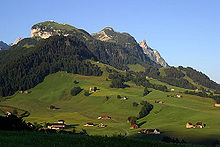Appenzellerland
Appenzellerland is the name of the hilly landscape of the two (semi) cantons Appenzell Ausserrhoden ( Protestant Reformed ) and Appenzell Innerrhoden ( Roman Catholic ) , characterized by pastureland and scattered settlements .
term
“Appenzellerland” is a geographical term; In a political context, the expression “both Appenzell” is used (see Canton Appenzell ). In the tourism industry outside of Eastern Switzerland , the term “Appenzell” is often incorrectly used for the Appenzellerland.
geography
Completely enclosed by the canton of St. Gallen , it is bounded in the north by the city of St. Gallen , in the east by the St. Gallen Rhine Valley , in the south by the Appenzell Alps with Säntis and Hohem Kasten and in the west by the Toggenburg . The mean altitude is 800 meters.
In the south of the country, the hilly, sparsely forested type of landscape gradually takes on a pre-Alpine character. The Ebenalp is a mountain range covered by alpine meadows, overlooked by bizarre rock formations. The Alpine peaks of Säntis and Churfirsten are at an altitude of two and a half thousand meters. The Säntis and the Altmann form a double peak, both of which are part of the Alpstein massif . In the foothills covered by high pastures, widely scattered farmsteads characterize the landscape. There is also the Seealpsee with its typically dark water level.
economy
In addition to agriculture (cheese production), the Appenzellerland mainly lives from tourism and small businesses. Pasture farming is still widespread today. In the southern Appenzellerland, the herds of cattle ascent and descent from the Alps is still a big event, framed by festivities, where traditional costumes are omnipresent.

Knitting
The traditional construction method in Appenzellerland, which still shapes the landscape today, is knitted construction, a block construction that allows full-surface cladding of the facades with panels and wood shingles thanks to special corner connections. Long ribbon windows with sunken shutters and colorful facades are typical of these mostly gable-free houses. The utility building stands along the side of the house. The resulting cross gable was often used in buildings without an economic building.
regional customs
Many old customs have been preserved in Appenzellerland:
- In the hinterland of the evangelical-reformed Appenzell Ausserrhoden the custom of the New Year's Eve is cultivated. Chlausen takes place on December 31st or January 13th, depending on the location.
- In the Catholic city of Appenzell Innerrhoden, women wear their traditional costume with hoods made of tulle embroidery on public holidays such as Corpus Christi .
- Also known are the carvings and the Appenzell peasant painting , as they are for. B. Albert Manser made.
- A special joke is ascribed to the people of Appenzell, and there is even a joke trail. This crosses the communities Wolfhalden , Walzenhausen and Heiden .
literature
- Isabell Herrmann: The farmhouses of both Appenzell (= The farmhouses of Switzerland. Volume 31). Basel 2004.
- Uta Hassler, Alexander von Kienlin, Fredi Altherr (eds.): Appenzeller Strickbau. Investigations into existing rural buildings in Appenzell Ausserrhoden. Zurich 2011.
Web links
- appenzell.info - Appenzellerland Tourism AI (Appenzell Innerrhoden)
- appenzellerland.ch - Appenzellerland Tourismus AR (Appenzell Ausserrhoden)
- Appenzellerland above Lake Constance - economic and location development of a sub-region
Individual evidence
- ↑ New Year's Eve ( Memento of the original from November 3, 2012 in the Internet Archive ) Info: The archive link was automatically inserted and not yet checked. Please check the original and archive link according to the instructions and then remove this notice. (Urnäsch Museum)
- ↑ Former Federal Councilor Merz loves the tradition of Swiss television, article from April 9, 2013, including broadcast from September 15, 2012



